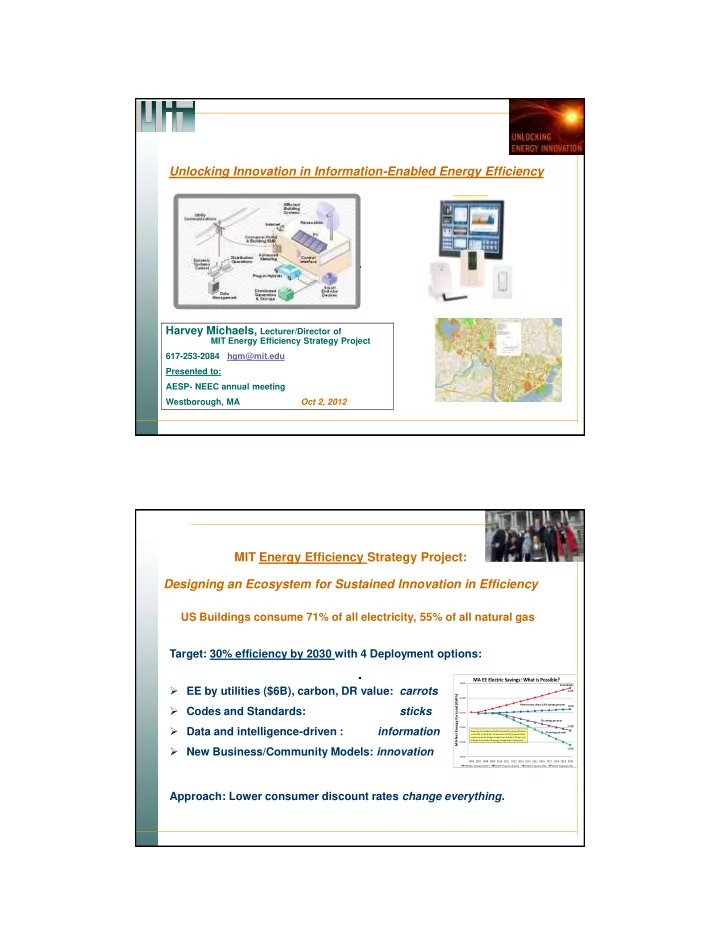

Unlocking Innovation in Information-Enabled Energy Efficiency Harvey Michaels, Lecturer/Director of MIT Energy Efficiency Strategy Project 617-253-2084 hgm@mit.edu Presented to: AESP- NEEC annual meeting Westborough, MA Oct 2, 2012 MIT Energy Efficiency Strategy Project: Designing an Ecosystem for Sustained Innovation in Efficiency US Buildings consume 71% of all electricity, 55% of all natural gas Target: 30% efficiency by 2030 with 4 Deployment options: MA EE Electric Savings: What is Possible? 70,000 EE by utilities ($6B), carbon, DR value: carrots Growth Rate 1.0% MA Net Energy for Load (GWh) 65,000 Recent years: about 0.8%savings per year Codes and Standards: sticks 0.2% 60,000 2% savings per year -1.0% Data and intelligence-driven : information 55,000 Acquiring all available cost-effective electric energy efficiency 3% savings per year as set forth in the Green Communities Act (GCA) would likely require an annual energy savings level of about 2.5% per year, or about three times the energy savings levels in past years. 50,000 New Business/Community Models: innovation -2.0% 45,000 2006 2007 2008 2009 2010 2011 2012 2013 2014 2015 2016 2017 2018 2019 2020 ISO Base Forecast (No EE) MA EE Programs (recent) MA EE Programs (2%) MA EE Programs (3%) Approach: Lower consumer discount rates change everything. 1
Energy 2.0: Integrated Energy Innovation Ecosystem and Policy Framework Connecting Systems: Disruptive Grid Innovations: Intermittent Renewables, Electric – Vehicles, CHP, Microgrid, Storage Utility/wholesale: AMI, dynamic pricing, demand response, – efficiency-EERS, forward capacity, carbon IP: “Smart buildings”, Home Networks – Markets/people: Data access, impactful – diagnostics/format/functionality, 2.0 community/city systems. What does the Smart Grid have to do with Energy Efficiency? Potentially, three strategies: Utility control of peak building energy use, Time-differentiated dynamic electricity pricing, and More frequent and granular energy consumption data to support operational improvements and behavior change. Illustration of Residential CPP Rate 1.2 Existing All-In CPP on Critical Days 1.0 CPP on Non-Critical Days 0.8 Rate ($/kWh) 0.6 0.4 0.2 0.0 0 2 4 6 8 10 12 14 16 18 20 22 24 Hour of Day 2
Consumer-responsive Architecture = Providing consumers with energy diagnostics, feedback, control refers to systems for optimizing consumers’ end -use needs (especially air conditioning, heat, hot water) based on weather, schedules, and time differentiated costs. Time-differentiated rates are more fair, and some would argue inevitable. Customer Responsive Systems work 24/7, providing efficiency as well as peak demand response. 2005 CA rate/technology impacts continue to be validated by other studies. 3
Granular Energy Data: - energy diagnostics, feedback, control Behavior impacts of smart grid-based information options may be as high as 30%: Fault-detection Daily Thematic Control – make me green End-use Control Precision Carbon Footprint? Adaptive Control Strategies Collective Action? Annual Savings from Feedback in Residential Programs (Ehrhardt-Martinez, Donnelly et al 2010) 4
Proposed Approach to Unlocking Efficiency Innovation: Transparency and Democratization Perhaps “Green Button” is less about energy data, and more about: Access to Efficiency, DR, and carbon mitigation measurement and rewards! Transparency: Agreed-to methodology for interpreting energy with other publicly available info to enable: Efficiency discovery (how much potential?) Efficiency measurement (how much saved?) Efficiency public credits (pass-through of regulatory benefits). Democratization : Policy-driven, long-term open access to savings benefits for businesses and communities. Efficiency, DR, carbon mitigation open to new market innovators. Effective framework by which innovations are measured, and then rewarded based on results. Energy Innovation Flows from Putting “Cards Face Up” “Sustained innovation is most likely if utilities/public policies create the enabling conditions for market- based systems” Transparency: “Green button” = “Efficiency meters”: – Making the invisible more visible. Democratization: Enabling New Market Innovators to get: – Open easy access to credits Harvey Michaels, Lecturer/Director of MIT Energy Efficiency Strategy Project 617-253-2084 hgm@mit.edu 5
Recommend
More recommend